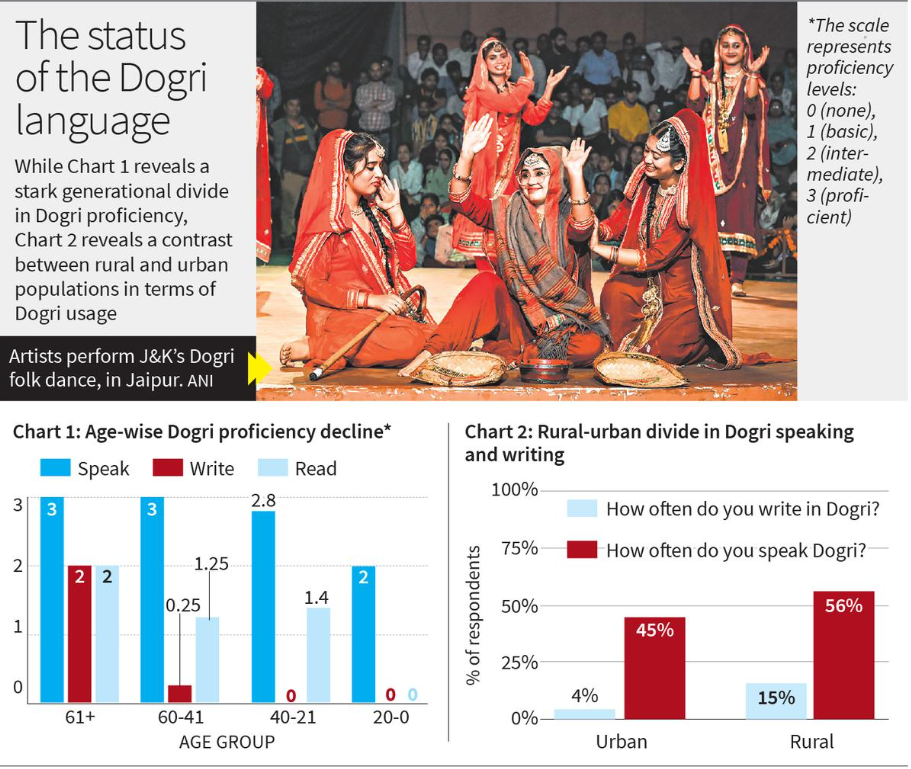Description
Copyright infringement not intended
Picture Courtesy: The Hindu
Context:
India is home to one of the world’s richest linguistic heritages, with hundreds of languages spoken across its regions. However, rapid modernization, migration, and the growing dominance of English and Hindi have caused many regional languages to decline. Among them is Dogri, a language native to the Jammu region and an integral part of Dogra identity.
History:
- Origins and Early Development: Dogri is an Indo-Aryan language primarily spoken in the Jammu region of the Indian Union Territory of Jammu and Kashmir, as well as in parts of Himachal Pradesh, Punjab, and northern Pakistan.
- Cultural and Literary Heritage: Dogri has a rich cultural history tied closely to Dogra identity and traditions. Folk songs, ballads, and oral poetry have been central to its preservation. Modern Dogri literature began to take shape in the early 20th century, with writers such as Pandit Dinu Bhai Pant, Ram Nath Shastri, and Ved Rahi contributing significantly to its development.
- Script and Written Tradition: Historically, Dogri was written in the Takri script, which was commonly used in the western Himalayan region. However, after the Dogra kingdom’s integration into modern India and the growing influence of Hindi and Urdu, Dogri gradually began to be written in the Devanagari script, which is now its official script.
- Recognition and Official Status: Dogri received constitutional recognition in 2003, when it was added to the Eighth Schedule of the Indian Constitution, granting it the same status as other national languages.
In 2020, it gained further prominence when the Jammu and Kashmir Official Languages Act recognized Dogri as one of the five official languages of the Union Territory — alongside Hindi, Urdu, English, and Kashmiri.
Current Status:
- According to the 2011 Indian Census, Dogri is spoken by ≈ 2,596,767 people in the Union Territory of Jammu & Kashmir.
- Decline in Functional Usage: Reports note that Dogri is “largely absent” from formal curricula and administrative usage, despite its official recognition in J&K.
- According to J&K Academy of Art, Culture and Languages research, language retention shows a sharp decline across age groups:
- Elders (60+): Strong in speaking and moderate in reading/writing Dogri.
- Middle-aged (41–60): Noticeable drop in writing ability.
- Young adults (21–40): Minimal literacy in Dogri.
- Youth (<20): Almost zero proficiency in reading or writing Dogri.
- If current trends continue, Dogri may shift from being classified as “vulnerable” (UNESCO category) to “definitely endangered” in the coming decades.
Implications of Dogri’s decline:
- Cultural Identity at Risk: Language is the most vital carrier of cultural memory and identity. The decline of Dogri threatens the Dogra community’s cultural heritage, including its folklore, traditions, and oral storytelling.
- Loss of Linguistic Diversity: India’s strength lies in its multilingual fabric. The erosion of Dogri contributes to the narrowing of India’s linguistic diversity, pushing the country closer to linguistic homogenization.
- Weak Intergenerational Communication: The growing gap between older and younger Dogri speakers has created a communication divide within families and communities.
- Educational and Economic Consequences: Because Dogri has limited representation in schools and public institutions, young speakers often view it as irrelevant to career or academic advancement.
- Threat to Folk Literature and Oral Traditions: Dogri’s oral literature — ballads, folk tales, and songs — faces extinction without active documentation and promotion.
- Policy and Governance Challenges: While Dogri has official status, its decline reveals gaps in language policy implementation. Recognition without institutional backing — in education, administration, and media — leads to symbolic rather than practical preservation.
Linkages between Dogri language and inclusive development:
- Language as a Tool for Social Inclusion: Language plays a crucial role in promoting social inclusion by allowing communities to participate meaningfully in public life. Promoting Dogri in public institutions ensures that people are not excluded due to linguistic barriers, thus strengthening democratic participation and equity.
- Preserving Cultural Identity and Local Knowledge: Inclusive development is not limited to economic growth; it also involves the preservation of cultural diversity. Dogri carries within it the collective wisdom, traditions, and indigenous knowledge of the Dogra community. This aligns with UNESCO’s emphasis that linguistic diversity is essential for sustainable development and cultural resilience.
- Education in the Mother Tongue: Research and global education policies (such as the National Education Policy 2020) stress that learning in one’s mother tongue enhances understanding, retention, and self-confidence in early education.
- Economic Empowerment through Cultural Industries: Dogri is deeply connected with local crafts, literature, theatre, and folk art. Promoting Dogri language and culture opens opportunities for creative industries, tourism, and handicrafts — providing livelihoods to artisans, writers, and performers.
- Strengthening Governance and Public Participation
Inclusive development requires that citizens understand and participate in governance processes. When administrative communication and public welfare schemes are available in Dogri, people in rural and semi-urban areas can better access government services, legal aid, and health or welfare information.
Government measures to revive Dogri language:
- Legal / Official-Status Measures: The Jammu & Kashmir Official Languages Bill, 2020 was passed, giving Dogri official-language status in the union territory of Jammu & Kashmir, alongside Urdu, Hindi, English and Kashmiri.
- Educational and Curriculum Measures: The School Education Department in Jammu announced that Dogri is being introduced as the “third major language” in government schools at the primary level: syllabi, textbooks for classes 1-12 are being developed.
- Dogri is being offered as an additional/optional subject in secondary classes (9-10) and as an elective in +2 level (10+2) in line with the National Education Policy 2020.
- Cultural, Publishing & Media Measures: To bring out a monthly tabloid in Dogri (scaling to weekly) to provide an outlet for Dogri writers and promote usage in print media.
Way Forward:
- Integrate Dogri into Education: Include Dogri as a compulsory subject at the primary level and as an elective in higher education. Train teachers and establish dedicated Dogri departments to ensure quality instruction.
- Strengthen Institutional and Policy Support: Ensure effective implementation of the J&K Official Languages Act (2020). Empower the Jammu and Kashmir Academy of Art, Culture and Languages (JKAACL) with funds and authority to promote Dogri across schools and administration.
- Promote Dogri in Media and Technology: Use digital platforms, social media, radio, and TV to modernize Dogri and attract younger audiences. Encourage Dogri journalism, literature, and content creation.
- Link Language with Livelihood: Connect Dogri with cultural tourism, folk art, and local crafts to create employment opportunities and make the language economically valuable.
- Encourage Community Participation: Organize Dogri festivals, cultural events, and school language clubs to inspire pride and daily usage. Families should speak Dogri at home to ensure intergenerational transmission.
- Preserve and Document Heritage: Support research, translation, and digital archives to protect Dogri literature, folklore, and oral traditions for future generations.
Conclusion:
Reviving Dogri requires a collective effort—through education, media, policy, and community action—to transform it into a living, dynamic language that continues to reflect the identity and pride of the Dogra people.
Source: The Hindu
|
Practice Question
Q. “Preserving regional languages like Dogri is as important as promoting economic development in India.” Discuss with reference to cultural identity, inclusive development, and social cohesion. (250 words)
|
Frequently Asked Questions (FAQs)
Dogri is an Indo-Aryan language primarily spoken in the Jammu region of Jammu & Kashmir. It is associated with the Dogra community and has a rich heritage of folk literature, music, and oral traditions.
According to the 2011 Census of India, around 2.3 million people speak Dogri as their mother tongue, mostly concentrated in Jammu, parts of Himachal Pradesh, and Punjab.
Dogri has a literary history spanning centuries, with contributions in poetry, folklore, and theatre. It preserves the cultural identity of the Dogra people and reflects their customs, traditions, and oral heritage.






